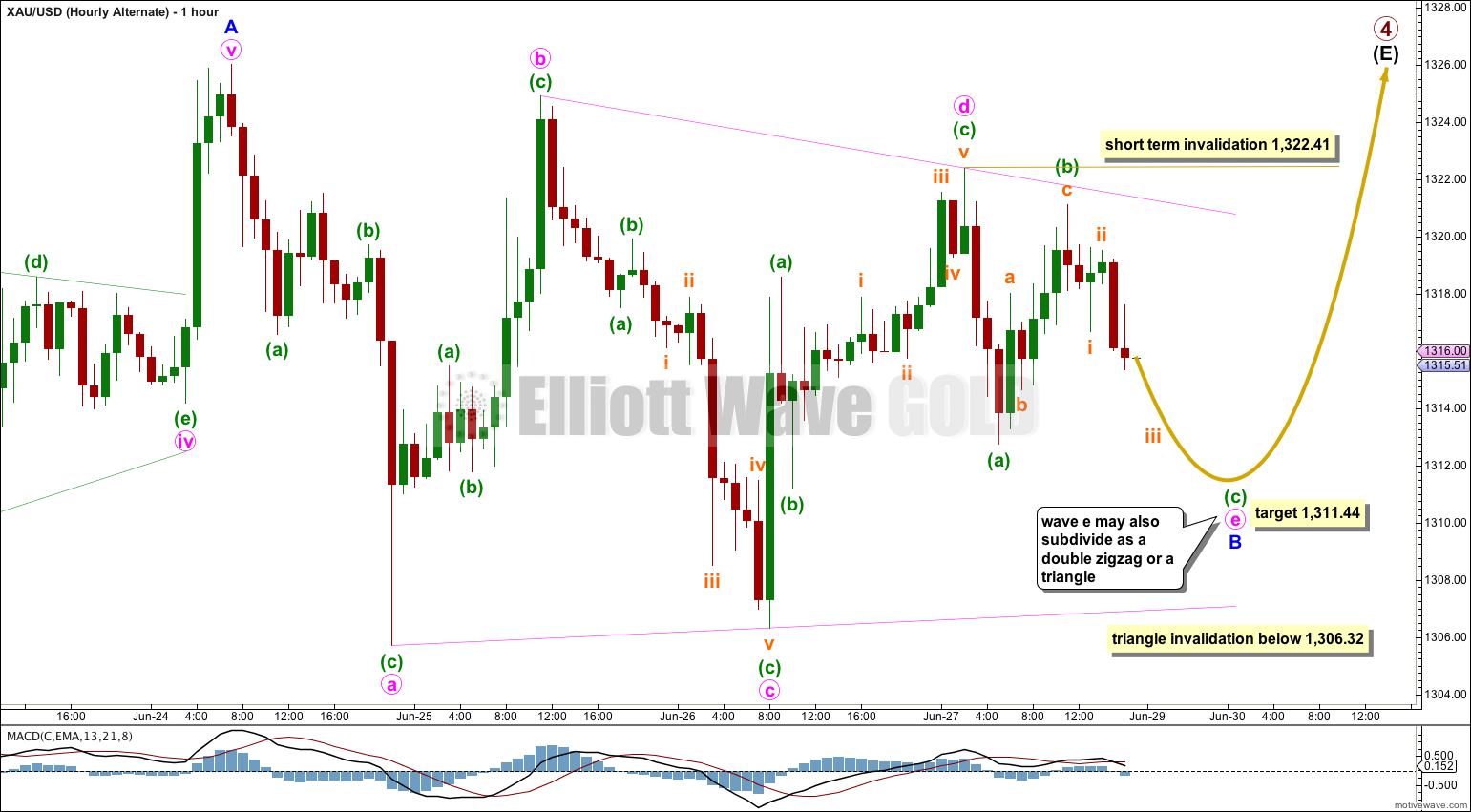Sideways movement continues as expected. Elliott wave count options for the B wave can now be narrowed down further. To end the week, I have two Elliott wave hourly charts for you.
Summary: Minor wave B is incomplete. I expect to see more choppy overlapping movement for another one or two days yet. When this sideways movement is complete the break out should be upwards.
Click on charts to enlarge.
Gold is still within a large fourth wave correction at primary wave degree which is incomplete.
Primary wave 2 was a rare running flat. Primary wave 4 is unlikely to be a flat correction because it is likely to show structural alternation with primary wave 2.
This wave count expects primary wave 4 is a huge triangle. The triangle is now within the final wave of intermediate wave (E) which should subdivide as a zigzag.
Intermediate wave (E) is most likely to fall short of the (A) – (C) trend line. It may also overshoot this trend line, but that is less common. If it does overshoot this trend line then it may find resistance, and end, at the upper edge of the bigger maroon channel on the weekly chart.
Within the zigzag of intermediate wave (E) minor wave B may not move beyond the start of minor wave A at 1,240.51. However, if minor wave B did manage to move substantially lower it should find strong resistance at the (B)-(D) trend line of the primary wave 4 triangle.
So far within primary wave 4 intermediate wave (A) lasted 43 days (no Fibonacci relationship), intermediate wave (B) lasted 88 days (just one day short of a Fibonacci 89), intermediate wave (C) lasted 53 days (just two days short of a Fibonacci 55) and intermediate wave (D) lasted 56 days (just one day more than a Fibonacci 55). So far intermediate wave (E) has lasted 18 days and is about halfway through. It may complete in a total Fibonacci 34 days, give or take one day either side of this expectation.
Main Hourly Wave Count.
Sideways movement fits so far as an incomplete double combination or contracting triangle (alternate below). At this stage I would only very slightly favour the combination option.
Within the combination minute wave w subdivides as a regular flat correction with a slightly truncated C wave.
Minute wave x joining the two structures in the double is a completed zigzag. This is the most common structure for X waves.
Minute wave y may be unfolding as a zigzag. Within it minuette wave (a) fits as a five wave structure and minuette wave (b) is an 87% correction of minuette wave (a); because this is less than 90% the length of minuette wave (a) minute wave y cannot be a flat correction.
Within minute wave y minuette wave (b) may not move beyond the start of minuette wave (a) at 1,322.41.
At 1,305.46 minuette wave (c) would reach 1.618 the length of minuette wave (a), and minute wave y would end slightly below the end of minute wave w. This would see the whole structure move sideways, which is the purpose of combinations. Minuette wave (c) would also breach the small channel about the zigzag of minute wave y.
Alternate Hourly Wave Count.
Alternatively, minor wave B may be completing as a regular contracting triangle.
Within a triangle all the sub waves must be corrective structures. Four of the five sub waves must be single or multiple zigzags. Only one of the sub waves may subdivide as a multiple, or a triangle itself.
Of the five sub waves of a triangle there does not have to be a multiple zigzag, but it is most common.
Minute wave e may subdivide as a single zigzag in which case it may be over soon. Minute wave e may also subdivide as a triangle or multiple zigzag in which case it would be more time consuming, and could take another two or three days to complete forming another nine wave triangle.
At 1,311.44 minuette wave (c) would reach equality in length with minuette wave (a). This target relies upon minute wave e completing as a single zigzag.
Within minute wave e minuette wave (b) may not move beyond the start of minuette wave (a) above 1,322.41.
Minute wave e may not move beyond the end of minute wave c at 1,306.32.
This analysis is published about 08:24 p.m. EST.




Hello Lara.
Can it be that wave 5 that you marked as minute wave 5 is a minuette wave 5 and price is now unfolding as minute wave 4 as a triangle so after wave e in this triangle completes then minute wave 5 will follow?
Hi Lara. Would you be able to do an update on silver soon? I am inclined to think that silver behaves like gold. Silver’s E wave is a double zigzag instead of the single that you posted. Which means that the E waves of both will end at the same time. Thereafter both will drop at the same time, silver completing the Intermediate C of Primary Y and gold Primary 5.